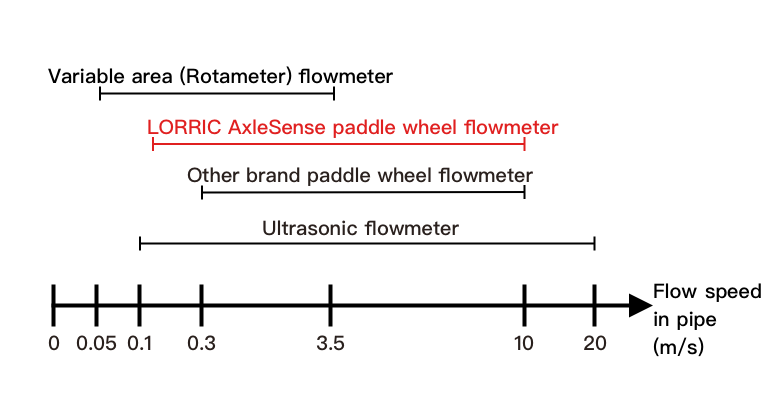Dalam memilih flowmeter akurat, dua faktor penting yang sering luput diperhatikan adalah rentang (range) dan linearitas (linearity). Keduanya berperan besar dalam menentukan seberapa tepat dan andalnya hasil pengukuran aliran fluida, baik itu air, bahan kimia, maupun cairan industri lainnya.
1. Apa Itu Rentang Flowmeter?

Rentang flowmeter mengacu pada kisaran laju aliran minimum hingga maksimum yang bisa diukur oleh alat tersebut. Rentang ini bergantung pada desain dan prinsip kerja flowmeter. Berbagai jenis flowmeter memiliki rentang yang berbeda, tergantung jenis aplikasinya.
Contoh rentang flowmeter berdasarkan jenis:
• Rotameter (flowmeter tipe float) : 0,05 ~ 3,5 m/s
• Flowmeter paddle wheel merek umum: 0,3 ~ 10 m/s
• Flow meter paddle wheel AxleSense LORRIC: 0.15~10 m/s
• Flow meter ultrasonik: 0.1~20 m/s
Ketika memilih flowmeter, sangat penting untuk menyesuaikan rentangnya dengan kebutuhan laju aliran (flow rate) fluida yang akan diukur. Jika rentangnya terlalu sempit, flowmeter tidak dapat mengukur laju maksimum. Sebaliknya, jika terlalu lebar, akurasi pengukurannya bisa menurun.
2. Apa Itu Linearitas Flowmeter?
Linearitas menggambarkan sejauh mana output flowmeter mengikuti proporsi langsung terhadap laju aliran aktual. Idealnya, flowmeter memiliki linearitas 100%, artinya hasil pengukurannya sebanding dengan aliran sesungguhnya. Namun dalam praktiknya, akan selalu ada sedikit penyimpangan.
Faktor-faktor yang memengaruhi linearitas flowmeter:
• Struktur dan prinsip kerja flowmeter
• Proses manufaktur
• Lingkungan kerja (tekanan, suhu, getaran)
Flowmeter dengan desain sederhana dan teknologi matang biasanya memiliki linearitas lebih tinggi. Demikian pula, flowmeter dengan kualitas manufaktur yang baik akan menunjukkan performa lebih konsisten. Di lingkungan industri dengan fluktuasi suhu dan tekanan, linearitas bisa menurun, yang pada akhirnya memengaruhi akurasi pengukuran.
Jika aplikasi Anda membutuhkan akurasi tinggi, pastikan memilih flowmeter dengan linearitas tinggi seperti flowmeter paddle wheel AxleSense atau flowmeter ultrasonik LORRIC.
3. Hubungan antara Rentang, Linearitas, dan Akurasi Flowmeter
Rentang dan linearitas saling memengaruhi. Flowmeter dengan rentang pengukuran yang sangat luas cenderung mengalami penurunan linearitas di batas atas atau bawah kisarannya. Artinya, output flowmeter bisa semakin menyimpang dari laju aliran aktual pada titik-titik ekstrem.
Untuk hasil terbaik:
• Pilih flowmeter dengan
rentang yang sesuai dengan kebutuhan proses.
• Dalam rentang tersebut, pastikan flowmeter memiliki
linearitas tinggi agar akurasi tetap terjaga.
Kesimpulan: Pilih Flowmeter yang Tepat untuk Akurasi Maksimal
Dalam dunia industri, memilih flowmeter yang akurat sangat penting untuk menjamin efisiensi dan keandalan proses. Jangan hanya melihat merek atau harga—perhatikan juga rentang dan linearitas, karena kedua faktor ini berpengaruh langsung terhadap akurasi pengukuran aliran.
Jika Anda sedang mencari:
- Flowmeter paddle wheel
- Flowmeter ultrasonik
- Rotameter untuk industri
Pastikan produk yang Anda pilih memiliki rentang dan linearitas yang sesuai dengan kebutuhan industri Anda.